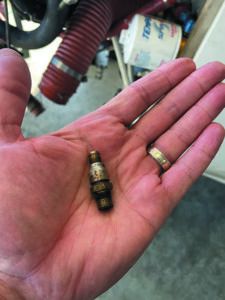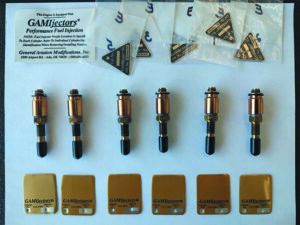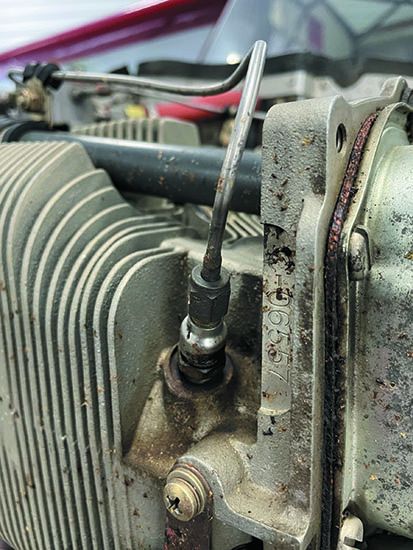They’re smaller than your thumb, inject a metered amount of fuel into each cylinder of your fuel-injected engine and rarely cause problems, but their maintenance needs should be understood as part of knowing the whys of your engine’s operation.
Fuel injection was developed to overcome some of the disadvantages of carburetors, notably unequal distribution of the fuel-air mixture to the cylinders. Currently, there are two fuel injection systems used commonly in our GA airplanes, Bendix-RSA and Continental Motors.
THE SYSTEMS
Used on all fuel-injected Lycoming and some Continental engines, the Bendix-RSA system uses a four-chamber fuel metering servo and a throttle body that routes metered fuel to a flow divider that divides the fuel into four or six equal packages and sends them to fuel discharge nozzles—we’ll use the terms fuel discharge nozzles and fuel injectors interchangeably—that are screwed into cylinder intake ports.
The Continental Motors system routes pressurized fuel from an engine-driven fuel injection pump to a fuel control unit containing valves controlled, respectively, by the throttle and mixture control, which meter the pressurized fuel and send it on to a flow divider that directs the fuel to the injectors in the cylinder intake ports.
Both systems are “continuous flow,” constantly spraying fuel into the intake ports whether the intake valve is open or closed. The nozzle measures engine air consumption and uses airflow forces to control fuel flow to the engine.
Bendix and Continental nozzles vary somewhat but are similar enough that we’ll simply refer to injectors generically in this article.
Radial holes (called bleeds) connect the nozzle’s inner bore with the air outside of the injector. The bleeds draw air through cylindrical screens and into the nozzle itself. The screens, and sharp bends in the bleeds, keep foreign materials in the air out of the nozzle.
The difference between engine manifold pressure and ambient air pressure determines how much air enters the nozzle.
Ambient air cannot be used to supply the nozzle air bleeds on turbocharged engines because manifold pressure higher than the pressure of the ambient air would force fuel out of the air bleeds. On those engines, sleeves are wrapped around the nozzles to allow the bleeds to be supplied with upper deck air pressure from the turbo-charger. Upper deck air pressure is always higher than the engine’s manifold pressure so air continues to go into the nozzle through the bleeds.
WHAT CAN GO WRONG?

Injector nozzles can get plugged, partially or completely. First of all, it’s rare—our informal survey of pilots flying injected-engine airplanes found fewer than one-quarter had ever experienced a plugged nozzle.
If a nozzle is partially plugged, fuel flow will be diminished, causing that cylinder to run leaner than the others. At very high power settings that can create a risk of detonation as the CHT climbs. The solution is to immediately reduce power, enrichen the mixture, land and dig into the problem.
At cruise power, a pilot running the engine rich of peak (ROP) may not notice a partially plugged nozzle because the cylinder may still be putting out close to the desired power (it’s the difference in power being developed by the cylinders that causes rough running when leaning).
When lean of peak (LOP), the symptoms will be a rough-running engine because the shape of a horsepower curve means that the effect of further leaning when LOP is to dramatically reduce the horsepower the cylinder is developing. ROP or LOP, an engine monitor will reveal which cylinder is the culprit.

The fix is cleaning the injector nozzle ultrasonically or with Hoppe’s #9 gun bore solvent.
PROPHYLACTIC CLEANING?
Recommended maintenance for injector nozzles is where things get interesting. Most aircraft and engine manufacturers call for the nozzles to be pulled and cleaned regularly.
However, because an injector is constantly being cleaned with a solvent (avgas), and there are two screens upstream of the nozzle, in the gascolator and fuel control unit, there is almost zero risk that something is going to plug it.
Our research revealed that the vast majority of plugged nozzle issues were maintenance-induced. We had reports of contamination introduced into nozzles in the remove-and-replace process, of mistorquing of nozzles leading to fuel leaks and of nozzles installed in wrong cylinders leading to big differences in fuel-air mixtures between cylinders.
We looked to George Braly of GAMI and Mike Busch of Savvy Aviation Inc., the country’s largest piston-engine aircraft maintenance organization. Both were adamant that if the engine has a four/six-probe EGT installed, there is no reason to engage in prophylactic cleaning of fuel nozzles. Their observations were that nozzle issues were almost always the result of problems caused by removing and cleaning nozzles that were already clean.
CONCLUSION
In our opinion, cleaning of injector nozzles is an on-condition maintenance item because cleaning is more likely to actually cause a problem than prevent one.





